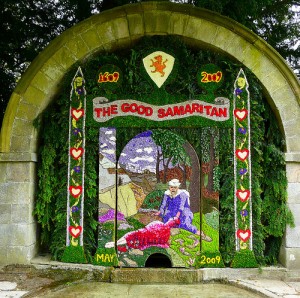In my second book, Just Say Yes, the hero participates in a village festival in which all the able-bodied men move a large stone in the village center in order to bring the village continued good fortune. This is something that actually took place annually in an English village. I ran across this odd activity in a book of English festivals, but I’ll be darned if I can find it now to give you the reference.
I was reminded of this recently when the wonderful Loretta Chase mentioned Hone’s Every-Day Book on her Two Nerdy History Girls Blog. This book describes itself as an “Everlasting Calendar of Popular Amusements, sports, pastimes, ceremonies, manners, customs, and events, incident to each of the three hundred and sixty five days in past and present times.” In short, it’s the ideal place to look for an interesting tidbit to spice up your story. The 1827 edition comes in two volumes of which I only have the first (but remain hopeful for obtaining the second half of the year).
It’s a delight to just page through the book and pick out an event. For example, on September 5, there is a long description of a visit to Bartholomew Fair in Stowe (or Smithfield as they appear to be interchangeable in this account) in 1825. The description encompassed many shows including the Largest Child in the Kingdom when young, the Handsomest Child in the World, The Persian Giant, The Fair Circassian with Silver Hair, The Female Dwarf, Two Feet Eleven Inches High, Two Wild Indians from the Malay Islands in the East… I could go on (and on).
You might learn that March 5 is St. Piran’s day (there are a lot of saints in this book, most described as “Romish”). St. Piran is, apparently, an Irish hermit who moved to Cornwall, had a grave made and then died in it. His day is reported to be a favorite with tinners as tradition has it that some secrets regarding the manufacture of tin was given by St. Piran.
The Every-Day Book covers everything from the laying of the first stone of London Bridge to Bastille Day. I can hardly wait to get my hands on volume 2.
More concise and focusing more on festivals, but less forthcoming about actual years in which they were celebrated is Yearbook of English Festivals. This might be where I got the stone moving ceremony, but I can’t find it right now. My copy of this one was published in 1954 and features some of the more esoteric festivals celebrated in England.
According to the Yearbook, well-dressing, or well-flowering, is observed in many English villages in the summer, particularly in Derbyshire and Staffordshire. This event involves decorating wells or springs with flower petals, allegedly to give thanks for its purity. No one seems really sure where it originated. I love it nonetheless. And, it’s still going on today. Welldressing.com has an extensive calendar.
I heartily recommend these fascinating compendia of yearly events and festivals. Not only are they great sources for settings and scenes, they’re a lot of fun just to browse.



I love books like this! Those unique little festivals and celebrations give such a touch of authenticity to a story. And I am forever fascinated by the people, places, events and things a village, county or nations chooses to celebrate.
Nice post, Myretta! I agree that those odd celebrations are great fun to read about, and can give nice local flavor to a story. My source for these is a 1986 publication, The Customs and Ceremonies of Britain, which may be easier to find than some of the other references mentioned, but one thing I don’t like about it is the way it is organized –alphabetically!! I would have thought organizing it by the calendar, or even by geographical locales, would have made more sense and been more useful. It is still fun to browse through and get ideas.
Thanks, ladies. These are fun. But I still wish I could locate my rock-moving ceremony.
Thanks for the book suggestions, Myretta!!!